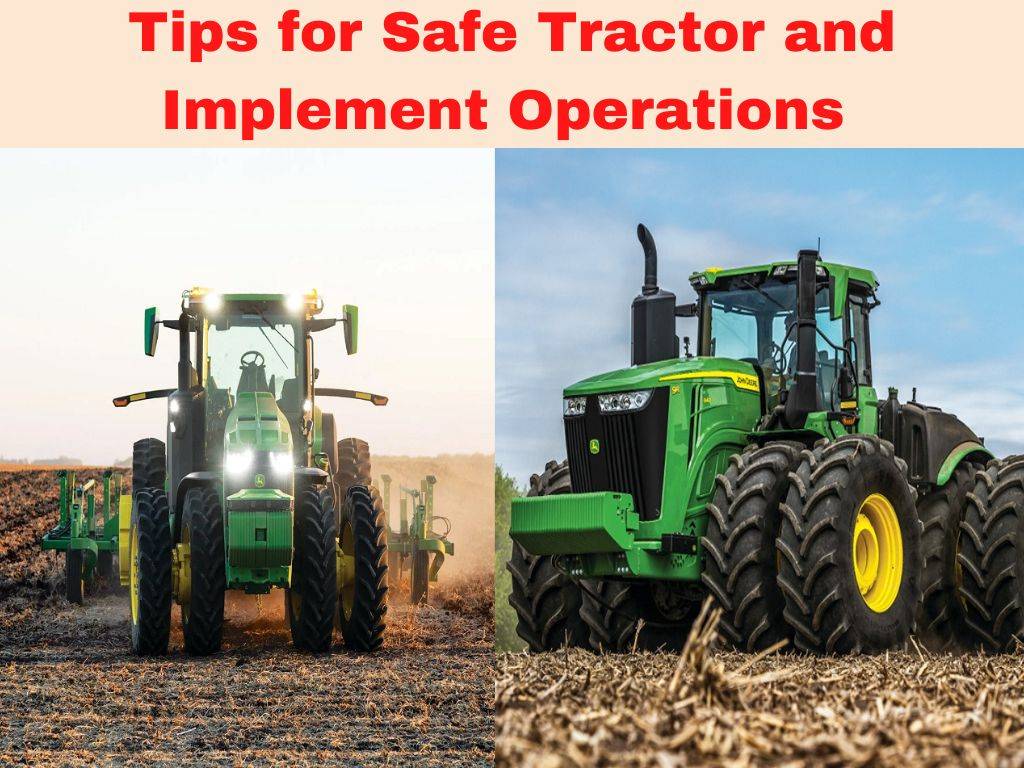
For today's high-production agricultural enterprises, modern farm tractors provide the majority of the muscle power required. Tractors are used to pull tillage equipment and wagons, transport equipment and goods, and carry mounted and semi-mounted implements. They are also used as remote power sources for other pieces of equipment.
Tractor accidents, sadly, cause deaths and severely disabling injuries every year. Property damage, medical expenses, time away from work, decreased productivity, and insurance costs all result in significant losses. Rollover falls, and collisions with tractor attachments are the main reasons for tractor-operator injuries and fatalities.
How to reduce the risk of Tractor Accidents
Be Physically and Mentally Fit
In deadly tractor-related accidents, a variety of human elements are present. A fatal tractor overturns accident can be caused by a number of circumstances, including bad decision-making, a poor attitude, a lack of knowledge or training, exhaustion, haste, stress, depression, alcohol, or a desire to show off.
When operating a tractor, each operator should be in good physical and mental health. A driver who is sleepy, exhausted, or unwell may not be able to respond quickly enough to prevent an accident. Your tractor performs the tasks you give it.
Have the Right Training
Poor decision-making by someone who does not know how to operate a tractor properly in potentially dangerous conditions can result in injury or death. Ensure that all individuals who are allowed to operate tractors have received enough training. The operator's manual is a good place to start training. With the tractor in front of you, review the operator's manual if at all possible.
Understand the Operator's Manual
Read the instructions in the operator's manual, then follow them. The operator will gain confidence when operating a tractor in challenging situations if they are familiar with its operating features. Find out where each indicator, control, and other indicator is located and what it does. In an emergency, being able to swiftly locate the controls by memory can help you act.
Accidents have occurred where people got caught in machinery or the power takeoff shaft, and the rescuers or family members were unable to free them. It is important to demonstrate to the family how to turn off the PTO or turn off the machinery in an emergency.
Examine the different labels you have on your equipment. For various locations on the tractor, they might display the words DANGER, WARNING, and CAUTION. Have a knowledgeable tractor operator with you as you examine the different decals and have questions answered!
Use Tractor for Intended Purposes
The tractor is useful across the farm, but misuse might lead to an accident. For instance, using the tractor to round up the cattle is risky since the operator can come across uneven, rough ground and make quick, sharp turns.
Check Tractor Before Operating
You can be confident that the tractor is in safe operating condition by doing a pre-operational check. Check the steering response, rear-view mirrors, slow-moving vehicle symbol, reflectors, and running lights for daytime or night-time operation, as well as the tires for correct inflation and faults. Also, check the windows for visibility.
Batteries: HANDLE WITH CARE!
Your tractor's battery may occasionally need to be handled, adjusted, or changed. Sulfuric acid, which is present in batteries, can seriously injure you if it comes in contact with your skin. They are also capable of producing hydrogen-oxygen gas mixtures that, when exposed to heat or sparks, can explode.
Hydraulic Systems and Safety
It can be dangerous to work with or on hydraulic equipment. Some of the risks are even difficult to see. The invisible threat is present where hydraulic systems are under extreme pressure.
Shutting down the engine:
Before turning off an engine, it should always be allowed to cool down at a fast idle. As a result, the pistons and valves can cool evenly. All hydraulic lift equipment should be lowered to the ground.
After turning off the tractor, fill the fuel tank once it has cooled a little. Verify that the park brakes are set. Ensure that the area around the exhaust system is free of combustible debris.
Take Special Care with Large Four-Wheel Drive Tractors With Articulated Steering
In addition to the skills required to operate a two-wheel-drive tractor, driving huge four-wheel-drive tractors with articulated steering demands additional abilities. Due to the tractor's increased power and size, as well as its increased speed and changed the field of view, the operator must pay careful attention to safety.
Operating your Tractor
Make sure you can easily reach the pedals and controls by adjusting the operator's seat. Check your visibility and adjust any side mirrors you may have. Take the time to clean the windows and mirrors if they require it. You don't want to miss a car behind a smudge and cause an accident on the road. Ensure that there are no obstacles or debris on the operator's platform. It happens frequently for something prevents the pedals from working properly. Before starting up your tractor, if it has a rollover safety structure, buckle your seatbelt.
Before putting the tractor in motion, make sure everyone is out of the way. In numerous deadly accidents, young children who were not seen were hit by moving vehicles. You might want to honk the horn occasionally to let others know that you're leaving. Additionally, you can use this as a chance to practice using the horn on the highway.
Tractor Stability
A tractor is sensitive to any shift in its center of gravity or balance point, and all tractor operators should be aware of this. On most tractors, it may be found just in front of the operator's seat and just above the height of the rear axle. This is the location around which all tractor weight balances. The stability of the tractor can fluctuate as a result of various forces and procedures.











